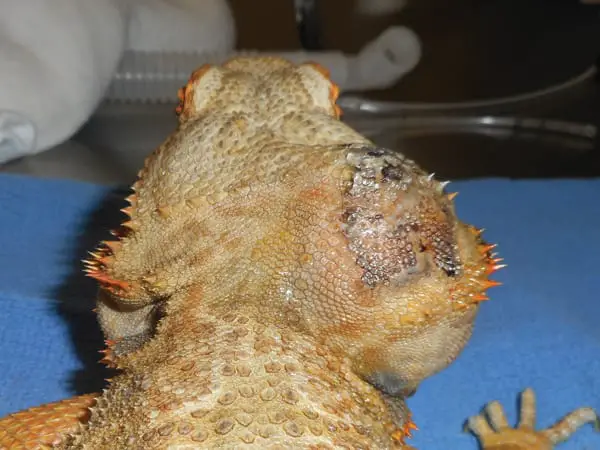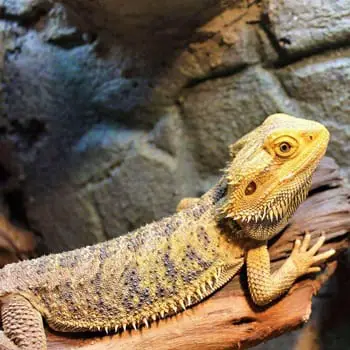It is common for different types of lizards to have bumps and lumps all over their bodies. In some cases, these are just normal parts of their bodies. However, such bumps and lumps can be quite serious and are signs that your reptile is suffering from kind of illnesses, disease, or health condition. Such is the case for Bearded Dragons.
Bumps on the head of Bearded Dragons have been some of the more common medical conditions that different pet owners have been talking about in the last decade. There has not been an exact diagnosis for those bumps that appear on the head of a Bearded Dragon, but many people have come to call it some sort of blood cyst or blood blisters. In some cases, they may even be called aneurysms.
Such a medical condition, whatever it is, can be pretty dangerous for your Bearded Dragon and can cause death if not treated right away. As such, there is a need for you to know what this is and how to diagnose and treat it properly if you want to prolong your Bearded Dragon’s life.
What is an aneurysm?
By its very definition, an aneurysm happens when an artery wall weakens and eventually bursts with enough pressure as blood runs through it. When this happens, there is a risk that someone who suffered from an aneurysm can end up with internal bleeding because of the ruptured artery. There is also a high chance that anyone who suffered from an aneurysm can die quickly if left untreated.
However, aneurysms are not always very dangerous. There are different types of aneurysms, depending on where they happen. They usually occur in the arteries in the brain and in the heart as it is believed that blood pressure in those areas tends to be high enough to rupture an artery with weakened walls. An aneurysm starts out like a bulge, which may rupture if the artery walls become too weak.
Aneurysms do not often show symptoms and may even not even be too dangerous to the point that they will not cause any kind of harm to someone or something who had just suffered from an aneurysm. However, the most dangerous types of aneurysms tend to be the ones that are severe. In the US, aortic aneurysms cause about 25,000 deaths in a single year. Meanwhile, 30,000 cases of brain aneurysms happen per year, while about 40% of those who suffer from brain aneurysms die within the next 24 hours.
Aneurysm in Bearded Dragons
Aneurysms are quite common to the point that not only humans suffer from them. It is not uncommon for reptiles such as Bearded Dragons to suffer from aneurysms as well even though there is no exact reason as to why these lizards are more prone to aneurysms than other animals are.
Bearded Dragons can suffer aneurysms in different parts of their bodies. This can happen in their legs, in their mouth, and near the hips. However, aneurysms in Bearded Dragons often occur at the top of their head and appears like the aforementioned bulge that many pet owners have been wondering about in the last decade or so. In fact, captive-bred Bearded Dragons, for some unknown reason, have been the only reported reptiles in captivity to suffer from aneurysms.
When opened and observed under a microscope, the bulge on the heads of the Bearded Dragon shows that the vessels lacked the elasticity of the usual blood vessels that other Bearded Dragons should normally have. Instead, they seem to be stiff and are not as well-suited to withstand high-pressure blood running through them. As such, there is always a risk for these vessels to bulge up, burst, and cause internal bleeding that can very well lead up to the death of the Bearded Dragon quickly if left unchecked and untreated.
Again, there are no exact reasons why Bearded Dragons are prone to aneurysms and why this happens to them. However, there have been cases where these lizards were able to recover from such a medical condition when they were treated by a medical professional.
Diagnosing aneurysms in your Bearded Dragon
The first thing that you should be wary of in relation to a possible aneurysm in your Bearded Dragon is the bulge that develops on the back part of its head, particularly on one side only. Once a swelling occurs on the back part of the head of the Bearded Dragon, there is a good chance that it is an aneurysm.
In that case, do not do anything on your own. Do not try to treat it or do anything else by yourself, for that matter. That should be the end of your personal diagnosis. Instead, the only thing you should do now is to bring your Bearded Dragon to a nearby veterinarian that specializes in reptiles and lizards. These vets are most likely going to be aware that aneurysms happen commonly in Bearded Dragons and are well-equipped with the knowledge and training to know how to diagnose this medical condition properly.
Veterinarians can do a lot of tests that can tell whether or not the bulge really is the cause of aneurysm. He or she can do a complete blood count or have your reptile go through a series of X-ray tests. Meanwhile, an ultrasound can help make sort things out because of how it can show the blood vessels in the bulge on the head of your Bearded Dragon. If your vet concludes that the cause of the bulge is a cephalic aneurysm, then he or she will proceed to tell you your treatment options.
Treating cephalic aneurysms

Similar to how you should never try to diagnose aneurysm in your Bearded Dragon all by yourself, you also should never try to treat it with any kind of at-home remedy you simply heard from your friends or read in a forum somewhere in the deepest corners of the internet. There are no at-home remedies or any kind of herbal treatment that can help your Bearded Dragon recover from an aneurysm.
The only possible way of treating an aneurysm in your Bearded Dragon is to take it to the vet and have it undergo surgery. This is the only way for you to treat it, and there are no other known means for treating this medical condition. More and more surgeries are done on Bearded Dragons to help them recover from this condition, and most of them have been successful.
However, there is no certainty as to how long they can keep on going right after surgery since not all Bearded Dragons came out completely healthy. The damage may have already been done, and the most that surgery can do is to help them prolong what remains of their life. In some cases, Bearded Dragons that underwent surgery to correct this medical condition were able to live 9 to 18 more months. If you compare that with Bearded Dragons that did not undergo surgery, the aneurysm will eventually rupture and will cause a quick death due to internal bleeding.
Even though there is a chance that your Bearded Dragon will only be able to live 9 to 18 more months after surgery, that still is better than having it die a quick and painful death if you just simply wait for the aneurism to erupt and cause internal bleeding that can be too hard on your lizard to bear. Your only course of action, in this case, should be surgery if you really want to prolong its life.
How do you prevent aneurysms in your Bearded Dragon?
As mentioned, there are still no possible answers as to why Bearded Dragons suffer from aneurysms while other pet lizards do not. It the cause of this medical condition is still unknown as of this writing. However, since it only happens in captive-bred Bearded Dragons, speculations have pointed to the possibility that it might be genetically passed from a common ancestor that was prone to this medical condition. Other than that, there are still no other causes that can explain why this condition happens.
Since there are no leads as to why Bearded Dragons are prone to aneurysms, it only follows that there are no known ways to prevent them. The only thing you can do is to make sure that a Bearded Dragon suffering from an aneurysm should be restricted in terms of its physical activities or else there is a huge possibility that the bulge will rupture and cause a quick and painful death. Again, your only recourse is to have it undergo surgery, but that can still be a very risky proposition given that surgical procedures to treat cervical aneurysms in Bearded Dragons tends to be very difficult even for the most skilled veterinarians.
Other common medical conditions in Bearded Dragons
Aside from aneurysms, here are the other common medical conditions you should be wary of when you are caring for a Bearded Dragon.
1. Metabolic bone disease
Metabolic bone disease is a medical condition that is common in a lot of pet reptiles due to a combination of their phosphorus-rich and low-calcium diet and lack of exposure to sunlight. This disease usually weakens their bones and muscles and may cause deformities or even injuries. The best way to combat this disease is to provide calcium supplements and to add a UVB lamp in your Bearded Dragon’s enclosure.
2. Respiratory infections
Bearded Dragons may suffer from different respiratory infections due to various causes. It might be because of high humidity levels in their enclosure. At times, it might be due to fluctuations in temperature. Always see to it that both the temperature and the humidity levels are at the right levels and that they stay consistent to avoid respiratory infections.



